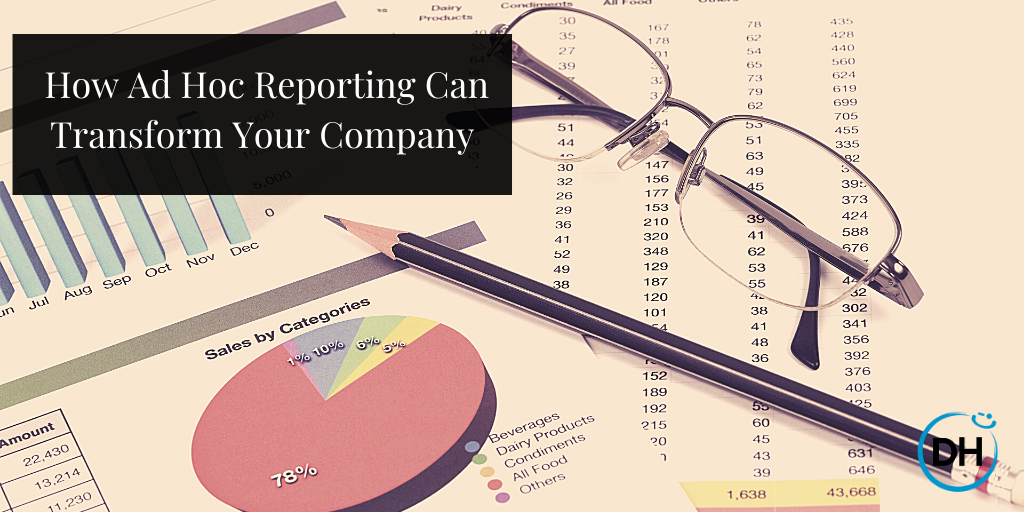
In today's business environment, companies require timely, accurate, and accessible data to help them make the best decisions. There is an increase in one-off requests for reports and business intelligence, and that's where ad hoc reporting comes in. With the right reporting tools, you can help different people across your enterprise efficiently access and utilize data according to their needs.
If that's something that interests you, then read on because this article takes a closer look at ad hoc reporting and how it can transform your company.
Ad hoc means "as the occasion requires" in Latin. Ad hoc reporting is a business intelligence (BI) model that involves creating and sharing reports for one-time use. It allows users to answer specific business questions using their reporting and analysis solutions on the fly or as the occasion requires.
With the right BI tools, it's possible to present the data in a visual format that is easy for everyone to understand. The technical user simply has to set up the ad hoc reporting solution, ensure the data has been loaded and made available, and then set the security parameters. After that, business end-users are given their account login details, and from that point on, they can create their own reports.
This type of reporting stands in stark contrast to managed reporting, as you'll discover below.
Ad hoc reporting is different from structured reporting in a variety of ways. Whereas structured reports are produced using formalized reporting templates and employ a large volume of data, ad hoc reports are only generated as needed and in a visual format relevant to the audience.
Also, structured reports are created by people with high levels of technical expertise and experience working with business intelligence tools to sift through and aggregate tons of data. In contrast, ad hoc reporting relies on smaller amounts of data, making it easier for people in an enterprise to report specific data points that help answer specific business questions.
For instance, most A/B testing tools offer ad hoc reporting features for website owners. Whether it's a big or small company doesn't matter. What matters is that customers can get the data they need quickly and on-demand.
There is no doubt that ad hoc reporting is vital for businesses. When there are questions that need to be answered quickly, it can provide insights more rapidly, reducing the time it would otherwise take to reach a decision.
The model has specific benefits and challenges that you should be aware of when choosing this solution for your business.
Ad hoc reporting is not a magic cure-all. Data must be used consistently and responsibly for this model to work. Some challenges come with its numerous benefits, some of which are listed below:
Incomplete Data
If you have some but not all your data in one place, this presents a significant limitation for ad hoc reporting. If your business uses extracted or siloed data, it could result in your reports becoming stale, which ultimately prevents you from getting a clear view of the complete picture. Or, if you have limited data due to a system you've built internally, such as an Intranet, the reporting may not be whole.
Data Availability
All the people in your organization need to be looking at the same underlying data. Otherwise, it can produce data chaos which would result in contradictory answers and delayed decisions.
Skills Gap
In most companies, the data team is responsible for creating ad hoc reports simply because gleaning helpful insights from data typically requires experience in data engineering and SQL.
Since many in the organization aren't equipped to do this type of work, such as college students who are part-time interns, producing ad hoc reports is often limited to a few people. A scenario like this creates a business intelligence bottleneck, which slows down data teams and business teams. The result is that the level of productivity suffers while everyone waits for answers.
Poor Data Governance
It's possible for ad hoc reporting to depart from your organization's developed metrics or available data. This may result in insights that are incompatible with other reports. That's why it's vital to have systems in place to ensure that the organization's data is handled consistently and appropriately across the entire business.
Departmental data analysts and business users most commonly use ad hoc reports. In some cases, ad hoc reporting access is shared outside the organization with outside auditors and business partners who may require secure access to the data.
When you should use ad hoc reporting depends on the answers to the following questions:
Ad hoc reporting can optimize performance across the entire organization in a variety of ways. For example, it can provide insights to help sales and marketing teams better engage with customers at every stage of the customer journey.
Ad hoc reporting can also help business development teams find new revenue streams or improve upon existing ones by analyzing the type of operational data needed to spot trends.
The ad hoc model makes sense when there is a need to address data analysis requirements not met by established recurring reporting that's already being produced in the business - whether on a day-to-day, weekly, monthly, or annual basis.
Ad hoc reporting can be utilized in a wide variety of industries, including:
Here is a more detailed example of ad hoc reporting in use in the healthcare industry:
Over six months, a busy hospital in New York sees a gradual rise in readmissions. Using their ad hoc reporting solution, they drill down and segment readmission rates according to departments. They discover that the cardiology department's readmission rate is unusually high, while the rates in other departments are historically unchanged. This insight leads the hospital to discover that the cardiology department is significantly understaffed, thus the lower quality of care. This, in turn, results in more patients returning after being discharged from the hospital. The hospital quickly reallocates staff and almost immediately begins to see the readmission rate drop.
To implement ad hoc reporting and scale in your organization, you can use a democratized reporting tool. Here are some of the steps to ensure a smooth rollout.
Choose the Right Tool:
Choose an ad hoc reporting solution that will empower all the people in your organization, not just the data team. The tool you use should be simple, and users should be able to create reports without the need for any technical skills.
Teach Data Skills
You need to ensure that all business users are taught basic data skills to get relevant insights. You can create a data literacy course or find white-labeled courses or programs to increase skills across the entire organization. If you have a large organization working remotely, as most companies are at the moment, consider using a platform to host webinars that can handle the capacity required.
Adopt Strategic Data Governance
Strong data governance will help ensure accurate and relevant data. However, it should be flexible enough to avoid creating bottlenecks in the process. You must recognize the balance between speed and standardization before deciding what's best for your company.
I hope this article has convinced you of the ways ad hoc reporting can transform your company. The ad hoc model helps you turn data into business insights so you can make better decisions. Use the information you've learned here to inform your organization's business decisions - both strategic and tactical so you can ensure your continued growth and success.
Over to you. Do you think your company stands to benefit from the ad hoc reporting model? Share your thoughts in the comments below!

Ron Stefanski is an online entrepreneur and college professor who helps people create and grow their own online businesses. He’s built a portfolio of websites that reaches millions of people yearly and continues to grow. Learn more about Ron by visiting OneHourProfessor.com.
You can also connect with him on YouTube or Linkedin, or on his Facebook Community.